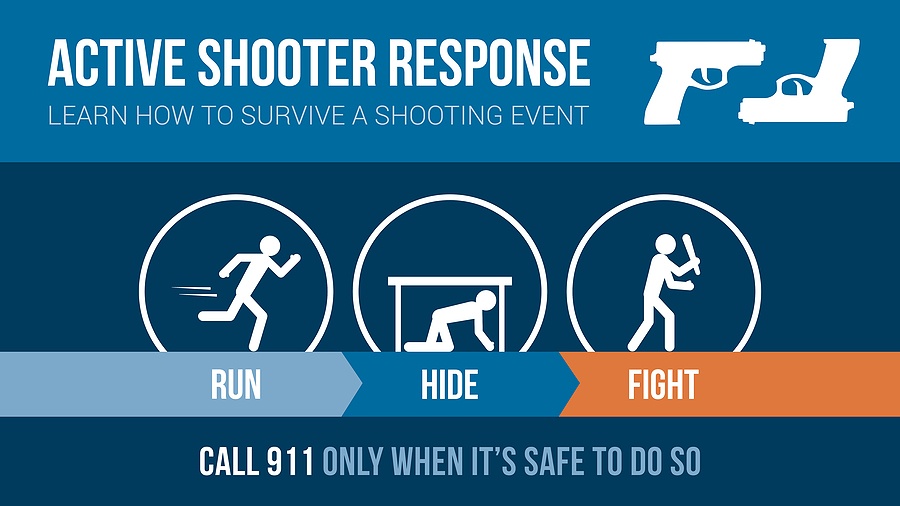Steps to Follow During an Active Shooter Attack

In an active shooter situation, employees and supervisors need to be emotionally and physically capable of dealing with the crisis to safeguard their own lives and those around them. Management must maintain composure, lock, and barricade all doors, and then evacuate all staff to a secure location via a pre-planned path. In that order, run, hide, or fight are the three most effective ways to respond to a scenario in which an active shooter is present.
Run
If an active shooter is present in your place of business or the surrounding area, your primary course of action should be to flee the area. Find out as quickly as possible which route out of the building is the most rational and can be reached easily. Leave your valuables where they are and remember always to keep your hands visible. Assist other people in escaping the area if you can and prevent more people from entering the site where the active shooter might be located.
Hide
If there is no quick way out of the area, you should take cover behind any accessible object that prevents you from having a clear line of sight of the person shooting at you. Heavy furniture and locked doors should be used to prevent anyone from finding your hiding place. However, it would be best if you tried to avoid restricting your possibilities for mobility outside of the region in which you are hidden. Maintain your silence, and check that the vibrate setting on your mobile phone is set to mute. Hold your position until the law enforcement officers arrive.
Fight
Fight or flight is the very last and only option left. Combat should only be used as a last resort and only be engaged when there is an immediate threat to one’s life. For this kind of response, you must give complete attention to the measures you are taking to incapacitate the active shooter by engaging in aggressive physical contact with them. Shout out as loud as you can, invent weapons, and use everything you can get your hands on to throw at the shooter and hurt them.
Making a 911 call
Call 911 as soon as it is secure enough to do so. Maintain vigilance for future attacks and assist others if you are in a position to do so. Provide the following information to the operator of the 911 call or law enforcement:
- Positions of the victims and the perpetrator who is still at large
- If there is more than one gunman, give their numbers.
- a description of the gunman or shooter’s physical appearance
- The number of weapons held by the shooter(s) as well as their types
- The number of people that could become victims at this site
The Arrival of Law Enforcement
As soon as they arrive, law enforcement’s priority will be to halt the active shooter and eliminate any further dangers that may exist. After that, they will go straight to where they heard the last rounds fired. The backup team will evaluate casualties and direct those who have survived to a secure area so that witnesses can be found and questioned so that the situation can be brought under control.
The survivors and victims of an active shooter situation should maintain their composure, put down any items they are holding, raise their hands and spread their fingers, refrain from making any jerky movements, pointing, screaming, or yelling, and pay attention to the directions given by first responders. Do not leave the secure area until police enforcement permits you.
Actions Following an Active Shooter Incident
After the situation has been controlled and the active shooter has been neutralized, management and human resources personnel should conduct post-event evaluation activities. These activities should include the following:
- Conduct a headcount of everyone in the secure zone to establish whether somebody is missing or may have been hurt.
- Determine the best way to contact family members who have been impacted by the tragedy, including notifying those who have been killed.
- Evaluate the person’s mental health while present, and if necessary, direct them to the appropriate health care professionals.
- Research the unfolding events involving the active shooter and write an after-action report.
- Considering the results of the investigation and the lessons learned, your company should revise its EAP.
